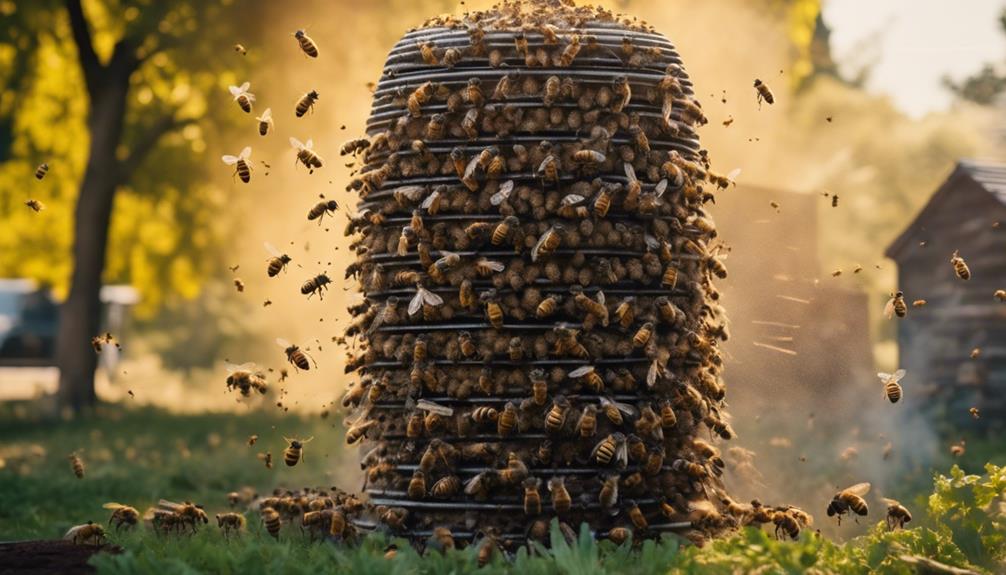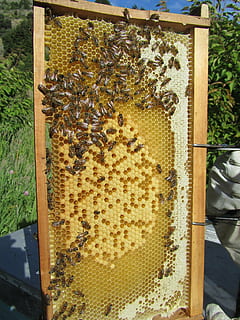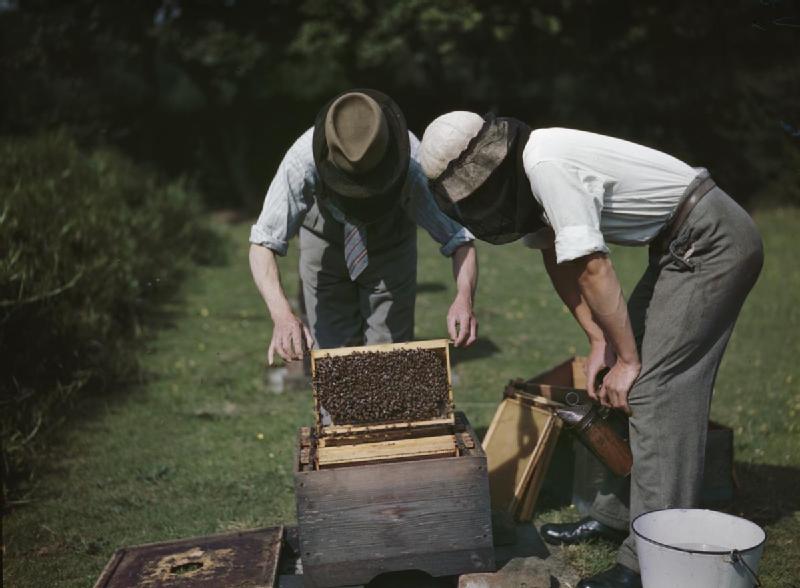
You definitely can have too many supers on a hive. Adding too many can stress out your bees, mess with their cozy temperatures, and mess up honey production. Imagine cramming too many guests into a small room - not fun! When your hive gets too hectic, it can even lead to colony collapse, which is a big no-no. Remember, a happy hive means happy bees. To find out how to strike the perfect balance for your hive, keep an eye out for signs of overload and manage their space wisely. Your bees will thank you for it!
Pros of Adding Multiple Supers
Adding multiple supers to a hive can significantly increase mastering beekeeping the honey production efficiency. When you provide your bees with more space to store honey, they can work more effectively, resulting in larger yields for you to enjoy.
With each super added, you give your busy bees the freedom to expand their honey-making operations, ensuring they've ample room to store nectar and produce delicious honey. This not only benefits you by providing more honey to savor but also benefits the bees by allowing them to thrive and fulfill their natural instincts.
Cons of Overloading With Supers
Maintaining a balance is crucial to avoid overwhelming your hive with too many supers, which can lead to hive stress, causing the bees to become agitated and potentially disrupt the overall colony dynamics.
This overcrowding may result in bees not being able to regulate the Bee-friendly plants hive's temperature effectively or efficiently manage resources like honey production.
It's important to strike a balance and make sure that you're not overwhelming your hive with more supers than they can handle to maintain a healthy and productive bee colony.
Hive Stress
When you overload a hive with too many supers, the added stress can negatively impact the health and productivity of the colony. Bees work hard to regulate the temperature, humidity, and cleanliness of their hive.
Adding excessive supers can disrupt this delicate balance, causing the bees to expend more energy and resources to maintain their home. This increased workload can lead to bee exhaustion, lower honey production, and even colony collapse in severe cases.
Just like how too many tasks can stress you out, overwhelming a hive with supers can overwhelm the bees. It's important to monitor your hive closely and make sure you're adding supers at the right pace to prevent unnecessary stress on your buzzing buddies.
Bee Colony Disruption
Excessive supers on a hive can disrupt the natural balance within the bee colony, leading to adverse effects on health and productivity. When you add too many supers, the bees may struggle to regulate the temperature and humidity, essential for brood development. This disruption can cause stress on the colony, leading to decreased honey production and weakened immune systems.
The overcrowding from too many supers can also result in increased competition for resources, potentially leading to conflicts among the bees. Additionally, an overwhelmed hive may become more susceptible to diseases and pests, impacting the overall well-being of the colony.
Therefore, it's essential to maintain a balanced number of supers to foster a harmonious and thriving bee colony.
Impact on Bee Health
Having too many supers on a hive can lead to overcrowding, which may stress the bees and impact their overall health.
When bees are overcrowded, they can become more susceptible to diseases and pests, affecting their productivity and well-being.
Monitoring the number of supers on your hive is essential to guarantee that your bees remain healthy and thriving.
Hive Overcrowding Effects
Overcrowding in a hive can significantly impact the health of bees. When bees face overcrowding, it can lead to various negative effects, such as:
- Increased stress levels among the bees. Higher risk of diseases and parasites spreading. Reduced ventilation within the hive, affecting air quality. Competition for food sources, potentially leading to malnutrition. Difficulty in maintaining ideal hive temperature and humidity levels.
Bee Stress Levels
When bees experience high levels of stress, their overall health and productivity can be significantly impacted. Just like humans, bees can feel the pressure too!
Stress in bees can arise from various factors such as overcrowding, disease, predators, or even environmental changes. When bees are stressed, they may become more susceptible to diseases and pests, leading to a decline in their population and honey production.
High-stress levels Beekeeping for beginners can also disrupt their daily routines, affecting their ability to forage for food and care for the hive. To keep your bees happy and thriving, it's essential to monitor their stress levels and provide a supportive environment.
Managing Hive Space Efficiently
To efficiently manage hive space, consider the best number of supers for your bees' needs. Here are some tips to help you make the most of your hive space:
- Regular Inspections: Check your hive regularly to assess space requirements accurately. Add Supers Gradually: Avoid overwhelming your bees by adding supers in stages. Monitor Honey Production: Assess how much honey your bees are producing to determine if additional supers are needed. Rotate Frames: Guarantee even distribution of bees and resources by rotating frames between supers. Space Optimization: Arrange frames efficiently to maximize space utilization without overcrowding.
Signs of Hive Overload
If your bees are struggling to maintain the hive temperature or are exhibiting increased aggression, these could be signs of hive overload. When your bees can't regulate the hive's temperature properly, it might indicate that there are too many bees for the space available.

Aggressive behavior, like more stinging or buzzing, could also be a sign that your hive is feeling cramped. Bees, like us, need their personal space to Pollination thrive, and overcrowding can lead to stressed-out colonies. Keep an eye on these signals from your bees; they're their way of telling you they might need more room.
In the next section, we'll explore finding the best number of supers to keep your hive buzzing happily.
Finding the Optimal Supers Number
Consider evaluating the number of supers in your hive to guarantee ample space for your bees to thrive and maintain a healthy colony. Here are some tips to help you find the best number of supers for your hive:
- Monitor Bee Activity: Regularly check how your bees are utilizing space in the hive. Observe Comb Building: Keep an eye on comb construction to gauge if more space is needed. Inspect Brood Area: Make sure there's enough room for the queen to lay eggs and for brood development. Check Honey Stores: Evaluate honey storage levels to determine if additional supers are required. Consider Seasonal Needs: Adjust the number of supers based on seasonal variations in nectar flow and bee population.
Balancing Honey Production & Bee Welfare
Ensure that your hive's honey production goals align harmoniously with the well-being of your bees. It's essential to find the sweet spot where your bees thrive while still maximizing honey yield.
Overloading your hive with too many supers can lead to stressed bees, affecting their health and productivity. Remember, happy bees mean more honey in the long run. Keep a close eye on your hive's population, ensuring it can effectively manage the supers you add.
Monitor honey stores regularly to prevent overcrowding or resource scarcity. By maintaining this delicate balance, you can enjoy bountiful honey harvests without compromising the well-being of your buzzing buddies.
Prioritize both honey production and bee welfare for a sustainable and fulfilling beekeeping experience.

Frequently Asked Questions
How Do Different Types of Supers Affect Hive Productivity?
Different types of supers can impact hive productivity by providing more space for bees to store honey. By using various sizes and styles, you can optimize storage efficiency and increase honey production in your hive.
Can Adding Too Many Supers Lead to Swarming Behavior?
Adding too many supers may overwhelm the hive, triggering swarming behavior. Inexperienced beekeepers often make this mistake. Make sure you monitor hive activity and space appropriately to prevent swarming and maintain a healthy colony.

What Are the Signs of Inadequate Hive Ventilation With Multiple Supers?
Maintain proper hive ventilation with multiple supers by observing signs like bees bearding excessively on the front of the hive, increased humidity inside, or a strong odor. Addressing these issues promptly is essential for healthy bees.
Do Certain Bee Breeds Handle Multiple Supers Better?
Certain bee breeds, like Carniolan and Buckfast, Beekeeping supplies handle multiple supers better due to their productivity and adaptability. Remember, choosing the right breed can make a significant difference in your hive's success.
Is There a Maximum Number of Supers Recommended for a Hive?
You can add supers to a hive, but be mindful of overdoing it. Monitor bee activity and space. Too many supers can overwhelm the colony, affecting health and productivity. Find the right balance for a thriving hive.